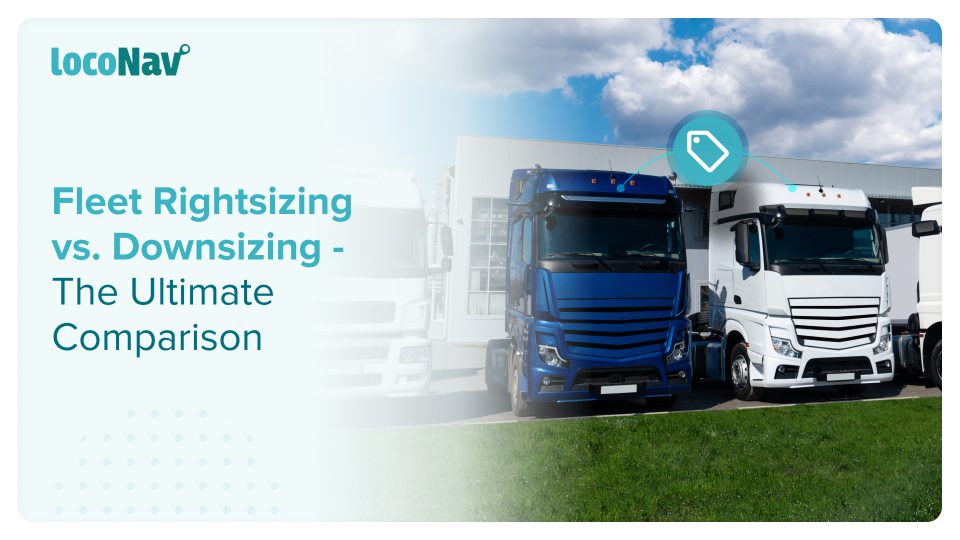

It appears that businesses are in an age where cost-cutting and savings are often regarded as the fundamentals of success, and this certainly applies to fleets. Terms like downsizing and rightsizing are the cornerstone of staying competitive by reducing costs. Rightsizing is used synonymously with downsizing; yet, a quick glance at the two reveals that they are not the same thing and cannot be used interchangeably.
Downsizing is the process of decreasing the number of your vehicle fleet to enhance usage, whereas rightsizing is the process of finding the perfect balance of fleet vehicles required to operate an organisation, which may not necessarily equal a reduced fleet size.
In this blog, we will discuss the difference between fleet rightsizing vs downsizing.
Manage your fleet efficiently with LocoNav’s Fleet Management Solutions!
What is Fleet Rightsizing?
Fleet rightsizing is a management approach that can assist vehicle fleet managers in developing and maintaining an optimum vehicle inventory. Vehicles that are specialised, rarely used, or unsuited for current purposes are frequently added to fleet inventories over time. Managers can optimise vehicle use, conserve fuel, minimise emissions, and save money on fuel and maintenance by reviewing fleet size and composition.
What is Fleet Downsizing?
Downsizing is a procedure that reduces the size of a workforce by terminating contractual contracts with employees. In terms of fleet operations, this means lowering the number of vehicles in order to improve efficiency, productivity, and competitiveness.
Rightsizing vs. Downsizing Based On:
Need
- Downsizing:
Corporate fleets are critical to many businesses, particularly those in the public sector. These company-owned vehicles enable personnel to conduct their jobs. However, these vehicles are frequently underutilised and spend longer in the parking area than on the road.
As a result, businesses end up paying a higher than necessary total cost of ownership (TCO). TCO covers, among other things, repair and maintenance costs, third-party service fees, and depreciation.
- Rightsizing
Most fleet managers are already aware of their vehicle count and type, typical mileage, payloads, and fuel economy. This data is combined with a close examination of fleet operations to discover additional chances for energy savings. When it comes to rightsizing, fleet managers need to consider how vital each vehicle is to the overall functioning of the fleet.
Metrics
- Downsizing
Since downsizing typically means reducing the number of vehicles, the metrics to evaluate fleet downsizing are
- No. of daily trips assigned
- No. of vehicles
- Trips per vehicle average
- Total cost of ownership
- Rightsizing
Fleet rightsizing is more complicated than just reducing the number of vehicles. The metrics that can be used to rightsize a fleet are
- Fuel economy
- No. of vehicles
- Average mileage of vehicles
- Total cost of ownership
- Vehicle Utilization
Process
- Downsizing
- Identify which vehicles and machinery are being used inefficiently.
- Evaluate the Total Cost of Ownership against profitability.
- Reduce the number of vehicles.
- Rightsizing
- Set an internal utilization criterion for the vehicles in your fleet.
- Determine how each vehicle will be used.
- Calculate the number of vehicles that are over and underutilized.
- Implement changes.
Benefits
- Downsizing
- Enhanced cash flow
- Remove all clutter.
- More time is required.
- Reduced utility bills.
- Rightsizing
- Increased profits
- Getting rid of redundant procedures.
- Optimizing staffing to fulfil targets.
- Vehicle redundancy reduction.
- Increasing readiness for future corporate growth
Tips on Optimizing Fleet Rightsizing And Downsizing
Understand Replacement Cycles
Replacement cycles are also directly tied to the issue of downsizing. When vehicles are replaced on time, fewer vehicles are typically required to achieve a given level of vehicle availability and performance. When a fleet renewal programme is launched, the need for a spare or backup vehicle decreases.
Hire A Consultant
The benefits of utilising an independent organisation include objectivity, providing the fleet manager with protective protection, and not putting him in the position of directing his clients on what to do.
Make Sure You Involve Your Drivers
Drivers may be on board if the company is shifting to new vehicles, but they may be frustrated if the options do not meet their expectations. If you want to start using lighter vehicles for your company purposes because you believe they will function just as well as larger ones, but your drivers are resisting, attempt to gather their feedback before committing to the purchase and explain your reasoning for the new acquisitions.
Consistently Conduct Auditing
Having visibility into your whole fleet’s activities, as well as the usage and costs of each vehicle, allows for frequent auditing, which leads to reasonable downsizing or optimisation methods that are applied gradually rather than as a knee-jerk reaction to specific, urgent situations. Set up and review these numbers to determine when it is time to take action with your fleet.
